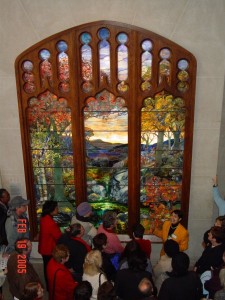The Autumn Landscape Window by Louis Comfort Tiffany
AUTUMN LANDSCAPE WINDOW
Researched by Rochelle Almeida
25.173
Artist: Louis Comfort Tiffany
Leaded Favrille Glass
11 ft X 8 ft. 6 in.
Tiffany Studios, New York, 1923-24
Gift of Robert W. de Forest, 1925
Who was Louis Comfort Tiffany?
Louis Comfort Tiffany (1848-1933) embodied the artistic spirit of America’s Gilded Age. He was the son of Charles Tiffany who founded the famous Tiffany store on Fifth Avenue, but declined the opportunity to follow his father into the family business in order to pursue his own artistic vision. The half century during which he worked in the decorative arts, i.e. from the 1870s to the 1920s, was a time of great experimentation, intense scrutiny of aesthetic ideals and gave rise to some of the century’s most exciting art movements, such as Art Deco and Art Nouveau, to all of which he contributed. Refusing to stay in one medium, Tiffany experimented vastly working with stained glass, enamel, jewelry, watercolor, metal, mosaic tile, etc. and was thus able to showcase his immense talents as a painter, architect and designer of interiors and landscapes
When was the window created and why?
The window was a private commission for the residence of Mr. L. D. Towle of Boston, Massachusetts, a real estate magnate and was meant to be housed in the Gothic style manor house that he was building outside the city. The style of the building dictated the Gothic tracery design of the window’s frame. It was meant to be installed on the second floor landing. Tiffany worked on the window between 1923 and 1924, but, unfortunately, Towle died bankrupt, shortly before the showpiece manor was completed and the window was never installed in his home. In due course, the Director of the Metropolitan Museum at the time, Robert W. de Forest, purchased it and then donated it to the new American Wing of this Museum.
Visual Details:
The scene depicted in the stained glass window is of a stunning autumn landscape, ablaze with the glowing colors and rich textures of the season. Considering that it was to be installed in Boston, it is appropriate that Tiffany chose to depict the grandeur of New England during its most spectacular season. The subject is a river that meanders at leisure through a valley. Mountains are visible in the distance and in the foreground, the woodland landscape dominates, notable for its foliage as much as for its rocks and tree trunks. The glow in the distance suggests sunset, that time of day when the earth is bathed in a golden softness and every conceivable autumn hue from burnished copper to blazing red from scorching yellow to tarnished rust is set on fire and enhanced by the sun’s dying rays. In that sense, the earth colors of the palette are contrasted by the vivid turquoise, almost purple, hues of the river.
Methods and Materials:
The window is made of a pane of Favrille or iridescent glass, united by striped of lead and encased in a wooden frame. Tiffany was doubtless influenced by the stained glass windows of European Medieval churches and monasteries. But he took the art of stained glass beyond its eccelesiastical setting and brought it into secular interiors, changing the essential nature of its subject matter which traditionally featured saints and scenes from the Bible and depicting instead Nature’s stunning possibilities. Thus, in this scene, he presents the woods in fall. In others, he has depicted the stillness of sheltered bays and the beauty of wisteria trailing over cottage eves.
Tiffany manipulated virtually every available type of glass and technique to give his window this extraordinary verisimilitude:
–Mottled glass creates intense sunlight filtered through yellow and green leaves.
–Confetti glass, so called because it is embedded with tiny paper-thin flakes of glass in different colors, adds realism to the foliage.
–Similarly, the boldly colored and marbleized glass simulates the gray and white boulders in the center and the striations on the white birch trees.
–Ripple glass evokes the movement of the water in the foreground.
–By plating several layers on the reverse, the artist created the impression of distant, misty mountain peaks.
Conclusion:
Louis Comfort Tiffany, through his studios and the vast numbers of artisans that were engaged in producing his designs, all of which he personally oversaw, created a massive inventory of decorative work, all of which has appreciated wildly with time and is highly valued today. This window is a fine testimony to Tiffany’s talents and skills as an artist and painter, designer and colorist.
BIBLIOGRAPHY:
MMA Bulletin. Special Issue on Louis Comfort Tiffany at the Metropolitan Museum. Summer, 1998.
Click here to continue the tour to see The Panorama of Versailles by John Van der Lyn
